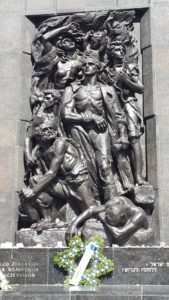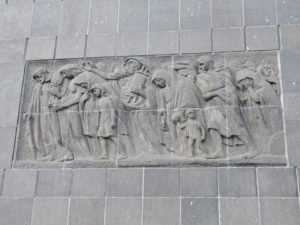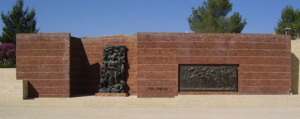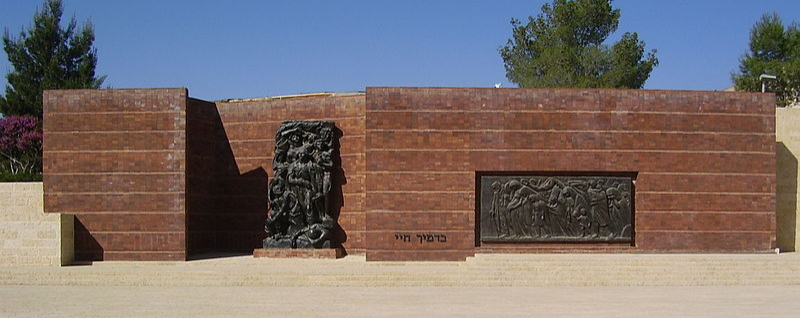The monument presents two tableaux. In one, seven figures of Jewish fighters are surrounded by flames. The figures all seem to surround one main figure, which may be a representation of Mordechai Anielewicz. Although the figure does not bear any resemblance to the young man who died in the Bunker of Mila 18 at the end of the uprising, it represents the symbolic characteristics of the Jewish fighter, of the fighting youth and the underground movement.
The second tableau presents the hardships and the victims of the ghetto. This is referred to as the last march, resembling the march of the spoils of Jerusalem on the Arch of Titus in Rome. In Rapoport’s march, the Jewish people carry a Torah scroll, rather than a Menorah.
Rapoport began sketching the monument in 1943, the moment he learned of the liquidation of the Warsaw ghetto. Rapoport was born in Warsaw, and by 1943, he was already a noted artist. His art began to be noticed only five years after he started his studies at the Art Academy in Warsaw. In 1936, when Rapoport was only 25 years old, one of his statues won a competition to be sent to Germany and showcased at the Olympic games. Rapoport refused to take the prize money, and refused to send the statue to Berlin, insisting that his art could not be disconnected from his Jewish heritage. With the outbreak of war, Rapoport fled to the Soviet Union. Here, he continued working as a sculptor, mainly on commissioned works by the Soviet regime. It was here he learned of the destruction of the ghetto, from a Polish newspaper printed in the Soviet Union.
Rapoport returned to Warsaw in 1946 to find a very different city to the one he had left a decade earlier. In the ruins of his hometown, he learned that almost all his Jewish family and friends had been murdered. Only a few months after his return to Warsaw, Rapoport was called to the Ministry of Infrastructure, which was planning the rebuilding of the city, and the first of many conversations for a monument to the Warsaw Ghetto began.

The West side of the Warsaw monument (Photo credit Yair Haklai, via Wikimedia Commons)
On the 5th anniversary of the Warsaw ghetto uprising, the 19th of April 1948, Rapoport’s monument was unveiled in front of twenty thousand people. Many of the attendees were survivors, coming from all over Europe for this commemoration and unveiling.

The East side of the Warsaw monument (Photo credit Vered Ben Artzi)
In 1963, on the 20th anniversary of the uprising, discussions began on the creation of a replica of this monument at Yad Vashem, the Holocaust museum in Jerusalem. The idea did not come to fruition until 1971, with the beginning of Dr. Yitzhak Arad’s post as the Director of Yad Vashem. Dr. Arad was a Holocaust survivor and a Holocaust historian who served as the director of Yad Vashem for 21 years. The monument in Yad Vashem was unveiled in 1976, 30 years after Rapoport created the original monument in Warsaw.
There are subtle differences between the two monuments, reflecting the values and desires of the two countries. In the tableau of the seven Jewish fighters, a woman’s figure stands in the background, looking out into the distance. On the Warsaw monument, the woman’s breasts are exposed, perhaps referencing the iconic Liberty Leading the People painting of the French revolution by Eugène Delacroix. In Israel, the woman’s breasts are covered, reflecting, perhaps, a difference in social mores between the two countries.

The Yad Vashem monument (Photo credit the author)
The two monuments are also laid out differently, and this is not by accident. In Warsaw the two tableaux are back-to-back. To view both, one must physically walk around the monument. In 1948, the monument stood on its own, surrounded by the ruins of the ghetto. Today, the western side, with the figures of the fighters, faces the entrance to the Polin Museum, a museum dedicated to the 1000 years of Polish Jewry, which opened in 2014. The eastern side, with the figures of the victims, faces the neighborhood of Muranów, built in the 1960s.
The monument in Yad Vashem has both parts of the sculpture side by side, like an open book. The tableaux are connected by the words of the prophet Ezekiel, “in thy blood, live,” added at the request of Dr. Arad. The right side of the monument, with the tableau of the victims, presents the hardships of the ghetto life. At first glance, these people appear weak or old, especially in comparison to the strong fighting youth on the left. However, the placement of these two side-by-side was deliberate. The two parts together remind viewers that resistance was demonstrated by all who remained in the ghetto in its final months, whether in hiding or in joining the resistance movements.
Arad requested to have this specific quote here to highlight the command to live and with it, the symbolism of rebirth. This monument serves as a backdrop to all the national Holocaust memorial ceremonies in Israel. The open book motif demonstrates the movement from the hardships of the Holocaust to this place on this mountain in this country, Israel. Connected by the quote, the monument portrays the movement from Holocaust to strength and bravery, from the Holocaust to rebirth, emphasizes the message that despite the Holocaust, the state of Israel exists and the people of Israel remain strong.


Great article, Lynne! I’m so excited for this new series.